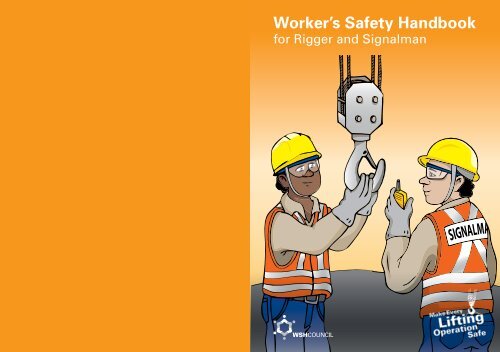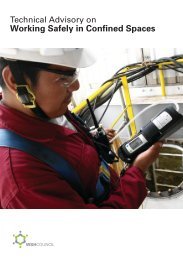Worker's Safety Handbook for Rigger and Signalman - Workplace ...
Worker's Safety Handbook for Rigger and Signalman - Workplace ...
Worker's Safety Handbook for Rigger and Signalman - Workplace ...
You also want an ePaper? Increase the reach of your titles
YUMPU automatically turns print PDFs into web optimized ePapers that Google loves.
Worker’s <strong>Safety</strong> <strong>H<strong>and</strong>book</strong><br />
<strong>for</strong> <strong>Rigger</strong> <strong>and</strong> <strong>Signalman</strong>
Contents<br />
Preface 3<br />
Proper Attire <strong>for</strong> <strong>Rigger</strong> <strong>and</strong> <strong>Signalman</strong> 4<br />
Roles <strong>and</strong> Responsibilities of a <strong>Rigger</strong> 5<br />
Good <strong>and</strong> Bad Rigging Practices 12<br />
Inspection of Hooks <strong>and</strong> Shackles 26<br />
Types of Wear <strong>and</strong> Tear <strong>for</strong> Wire Ropes 28<br />
Roles <strong>and</strong> Responsibilities of a <strong>Signalman</strong> 31<br />
Recommended Crane H<strong>and</strong> Signals 33<br />
Good Communication Practices 36<br />
Year of issue: 2011<br />
2
Preface<br />
This h<strong>and</strong>book serves as a workplace safety <strong>and</strong> health<br />
resource <strong>for</strong> workers who are involved in work activities<br />
involving lifting equipment such as cranes. The <strong>Rigger</strong> <strong>and</strong><br />
<strong>Signalman</strong> h<strong>and</strong>book highlights general safety pointers to<br />
ensure safe lifting operations. This h<strong>and</strong>book was developed<br />
to assist the <strong>Rigger</strong> <strong>and</strong> <strong>Signalman</strong> to better underst<strong>and</strong> their<br />
roles <strong>and</strong> responsibilities, show examples of good <strong>and</strong> bad<br />
practices <strong>for</strong> loading <strong>and</strong> rigging, per<strong>for</strong>m basic inspection<br />
of lifting equipments such as hooks, shackles <strong>and</strong> wire ropes,<br />
adhere to good communication practices, <strong>and</strong> recognise crane<br />
h<strong>and</strong> signals.<br />
1. Proper Attire <strong>for</strong> <strong>Rigger</strong><br />
<strong>and</strong> <strong>Signalman</strong><br />
Wear personal protective equipment (PPE)<br />
Put on the proper attire <strong>and</strong> PPE at all times<br />
Helmet<br />
Identification<br />
Tag<br />
Helmet<br />
Identification<br />
Tag<br />
This h<strong>and</strong>book is produced <strong>for</strong> education <strong>and</strong> in<strong>for</strong>mational<br />
purposes by the National Crane <strong>Safety</strong> Task<strong>for</strong>ce <strong>and</strong> <strong>Workplace</strong><br />
<strong>Safety</strong> <strong>and</strong> Health Council <strong>and</strong> serves as a reference <strong>for</strong><br />
good practices.<br />
Reflective<br />
Vest<br />
<strong>Safety</strong><br />
Boots<br />
Gloves<br />
Reflective<br />
Vest<br />
<strong>Safety</strong><br />
Boots<br />
Gloves<br />
Figure 1: <strong>Signalman</strong> attire<br />
Figure 2: <strong>Rigger</strong> attire<br />
3 4
2. Roles <strong>and</strong> Responsibilities of<br />
a <strong>Rigger</strong><br />
Check slings<br />
3. Roles <strong>and</strong> Responsibilities of<br />
a <strong>Rigger</strong><br />
Check load<br />
Check the slings <strong>and</strong><br />
ensure that the rigging<br />
angle is correct.<br />
Make sure the load is properly<br />
secured <strong>and</strong> in<strong>for</strong>m the Crane<br />
Operator of the weight of the load.<br />
5 6
4. Roles <strong>and</strong> Responsibilities of<br />
a <strong>Rigger</strong><br />
Check lifting gears<br />
5. Roles <strong>and</strong> Responsibilities of<br />
a <strong>Rigger</strong><br />
Ensure load lifted is safe <strong>and</strong> balanced<br />
Make sure the lifting gears such as slings<br />
<strong>and</strong> shackles are well-maintained <strong>and</strong> in<br />
good working condition.<br />
Make sure the load is stable,<br />
secured <strong>and</strong> balanced be<strong>for</strong>e any<br />
lifting operation.<br />
7 8
6. Roles <strong>and</strong> Responsibilities of<br />
a <strong>Rigger</strong><br />
Ensure loose loads are secured<br />
7. Roles <strong>and</strong> Responsibilities of<br />
a <strong>Rigger</strong><br />
Report defective lifting gear to<br />
Lifting Supervisor<br />
Make sure any loose items are placed in a<br />
proper receptacle or container to prevent the<br />
load from falling during the lifting operation.<br />
Immediately report any defective<br />
or faulty lifting gear to the Lifting<br />
Supervisor.<br />
9 10
8. Roles <strong>and</strong> Responsibilities of<br />
a <strong>Rigger</strong><br />
Use paddings on the load edges<br />
9. Good <strong>and</strong> Bad Rigging Practices<br />
Correct use of choker hitches<br />
Figure 3: Make sure there is no cutting action on the running line.<br />
Place adequate paddings on the<br />
edges of the load to prevent the<br />
sling from damage.<br />
Figure 4: Do not use shackle<br />
pin as it will become loose over<br />
time.<br />
Figure 5: Make sure there is no<br />
cutting action of the wire rope<br />
sling eye on the running line.<br />
11<br />
12
10. Good <strong>and</strong> Bad Rigging Practices<br />
Correct way to balance a shackle load<br />
11. Good <strong>and</strong> Bad Rigging Practice<br />
Correct hook-up methods<br />
Packings<br />
Hook<br />
Washers<br />
Figure 8: Make sure the safety latch is in good condition.<br />
Figure 6: Insert sufficient washers to centralise the position of<br />
the shackle.<br />
Figure 9: Make sure the shackle is hooked up correctly.<br />
Figure 7: Make sure the shackle is not pulled down at an angle.<br />
45° 45°<br />
Figure 10: Make sure the shackle is equally spaced apart.<br />
13 14
12. Good <strong>and</strong> Bad Rigging Practices<br />
Correct rigging method<br />
Figure 12: Secure the hooks facing out.<br />
Figure 11: Wrong hooking up method.<br />
Figure 13: Do not secure the<br />
hooks facing in.<br />
Figure 14: Do not wrap a rope<br />
around the hook.<br />
15 16
13. Good <strong>and</strong> Bad Rigging Practices<br />
Correct rigging method<br />
14. Good <strong>and</strong> Bad Rigging Practices<br />
Correct rigging method<br />
It will tilt to one side<br />
Figure 15: Make sure the load is rigged correctly be<strong>for</strong>e lifting.<br />
Figure 17: Do not tie the sling from one eye bolt to another as it will<br />
tilt to one side.<br />
Figure 16: The load will tilt to one side during lifting if it is not rigged<br />
correctly.<br />
17 18
15. Good <strong>and</strong> Bad Rigging Practices<br />
Hook up unused slings<br />
16. Good <strong>and</strong> Bad Rigging Practices<br />
Correct loading method<br />
Load<br />
Load<br />
Result<br />
Figure 20: Correct<br />
loading method.<br />
Figure 21: The eye bolt will bend if<br />
loading is not done correctly.<br />
Figure 18: Make sure any unused slings are hooked up properly.<br />
Figure 19: Do not leave unused slings unhooked.<br />
19 20
17. Good <strong>and</strong> Bad Rigging Practices<br />
Use paddings during lifting<br />
18. Good <strong>and</strong> Bad Rigging Practices<br />
Correct methods of joining sling eyes<br />
Shackles<br />
Shackles<br />
Sling Eye<br />
Figure 22: Correct ways of using paddings to prevent damage to the<br />
sling.<br />
Figure 24: Use a shackle to join the sling eyes.<br />
No Padding<br />
Figure 23: The sling will be damaged if paddings are not used on the<br />
load.<br />
Figure 25: Wrong method of joining the sling eyes.<br />
21 22
19. Good <strong>and</strong> Bad Rigging Practices<br />
Use original screw pin<br />
20. Good <strong>and</strong> Bad Rigging Practices<br />
Use tag line to control movement of the load<br />
Original Screw Pin<br />
RIGGERMAN<br />
Figure 26: Use the original screw pin <strong>for</strong> the shackle.<br />
Bolt<br />
Figure 27: Do not use a bolt as a screw pin as it will bend.<br />
Use a tag line to control the<br />
movement of the load during<br />
a lifting operation.<br />
23 24
21. Good <strong>and</strong> Bad Rigging Practices<br />
Correct method of unloading<br />
22. Inspection of Hooks <strong>and</strong> Shackles<br />
Check hook <strong>for</strong> any defects <strong>and</strong> make sure<br />
it is in good working condition<br />
Shoring Planks<br />
Check <strong>for</strong><br />
cracks <strong>and</strong><br />
twisting<br />
Check <strong>for</strong> wear <strong>and</strong><br />
de<strong>for</strong>mation<br />
Signs of<br />
“Opening Up”<br />
Figure 28: Place load on shoring planks during unloading.<br />
Check <strong>for</strong> wear <strong>and</strong> cracks<br />
Check that<br />
hook is not<br />
twisted<br />
Figure 29: Do not use the crane to pull out the sling from under the load.<br />
25 26
23. Inspection of Hooks <strong>and</strong> Shackles<br />
Check shackle <strong>for</strong> any defects <strong>and</strong> make<br />
sure it is in good working condition<br />
24. Types of Wear <strong>and</strong> Tear <strong>for</strong> Wire<br />
Ropes<br />
Check wire ropes <strong>for</strong> any defects <strong>and</strong> make sure<br />
they are in good working condition<br />
Check wear<br />
Check cracks,<br />
bending <strong>and</strong><br />
twisting<br />
Figure 30: Crushed severely.<br />
Pin always<br />
seated<br />
Check<br />
wear <strong>and</strong><br />
straightness<br />
Check<br />
opening width<br />
Figure 31: Flatten severely.<br />
27 28
25. Types of Wear <strong>and</strong> Tear <strong>for</strong> Wire Ropes<br />
Check wire ropes <strong>for</strong> any defects <strong>and</strong> make sure<br />
they are in good working condition<br />
26. Types of Wear <strong>and</strong> Tear <strong>for</strong> Wire Ropes<br />
Check wire ropes <strong>for</strong> any defects <strong>and</strong> make sure<br />
they are in good working condition<br />
Figure 32: Bird cage.<br />
Figure 37: Bulged severely.<br />
Figure 33: Dog-leg kink.<br />
Figure 38: Core protrusion.<br />
Figure 39: Excessive clearance between str<strong>and</strong>s.<br />
Figure 34: Kink.<br />
Figure 35:<br />
Open kink.<br />
Figure 36:<br />
Closed kink.<br />
29 30
27. Roles <strong>and</strong> Responsibilities of<br />
a <strong>Signalman</strong><br />
Check load is properly rigged<br />
28. Roles <strong>and</strong> Responsibilities of<br />
a <strong>Signalman</strong><br />
Give correct crane h<strong>and</strong> signals<br />
Check the load is properly rigged<br />
be<strong>for</strong>e giving clear signal to the<br />
Crane Operator to lift the load.<br />
Give the correct crane h<strong>and</strong><br />
signals clearly to the Crane<br />
Operator to lift the load.<br />
31 32
29. Recommended Crane H<strong>and</strong> Signals<br />
Underst<strong>and</strong> <strong>and</strong> practice correct<br />
crane h<strong>and</strong> signals<br />
Hoist<br />
Lower<br />
Jib Up<br />
Derricking Jib<br />
Jib Down<br />
Figure 42: Clench <strong>and</strong> unclench fingers to signal<br />
take the strain.<br />
Figure 40: Signal with one h<strong>and</strong>. Other h<strong>and</strong> on head.<br />
Slew Left<br />
Slew Right<br />
Travel to me<br />
Travel from me<br />
Figure 43: Arm extended, pointing with finger in<br />
direction of swing of boom.<br />
Figure 41: Signal with both h<strong>and</strong>s.<br />
33 34
30. Good Communication Practices<br />
Practice good communication within<br />
the Lifting Team<br />
Extend Jib/<br />
Trolley Out<br />
Retract Jib/<br />
Trolley In<br />
Telescoping Jib/ Horizontal Jib<br />
Figure 44: Signal with one h<strong>and</strong>. Other h<strong>and</strong> on head.<br />
LIFTING<br />
PLAN<br />
<strong>and</strong><br />
SWP<br />
Stop<br />
Emergency<br />
Stop<br />
Figure 45: Clench <strong>and</strong> unclench fingers to signal<br />
inch the load.<br />
Communication between Lifting<br />
Supervisor, <strong>Rigger</strong> <strong>and</strong> <strong>Signalman</strong><br />
must be maintained at all times.<br />
35 36
31. Good Communication Practices<br />
Practice good communication within<br />
the Lifting Team<br />
Published in July 2011 by the <strong>Workplace</strong><br />
<strong>Safety</strong> <strong>and</strong> Health Council in collaboration<br />
with the Ministry of Manpower.<br />
All rights reserved. This publication may not be<br />
reproduced or transmitted in any <strong>for</strong>m or by any<br />
means, in whole or in part, without prior written<br />
permission. The in<strong>for</strong>mation provided in this<br />
publication is accurate as at time of printing.<br />
All cases shared in this publication are meant <strong>for</strong><br />
learning purposes only. The learning points <strong>for</strong><br />
each case are not exhaustive <strong>and</strong> should not be<br />
taken to encapsulate all the responsibilities <strong>and</strong><br />
obligations of the user of this publication under<br />
the law. The <strong>Workplace</strong> <strong>Safety</strong> <strong>and</strong> Health Council<br />
does not accept any liability or responsibility<br />
to any party <strong>for</strong> losses or damage arising from<br />
following this publication.<br />
This publication is available on the<br />
<strong>Workplace</strong> <strong>Safety</strong> <strong>and</strong> Health Council<br />
Website: www.wshc.sg<br />
Email: contact@wshc.sg<br />
<strong>Rigger</strong> <strong>and</strong> <strong>Signalman</strong> must<br />
maintain good communication<br />
between each other at all times.<br />
37

















